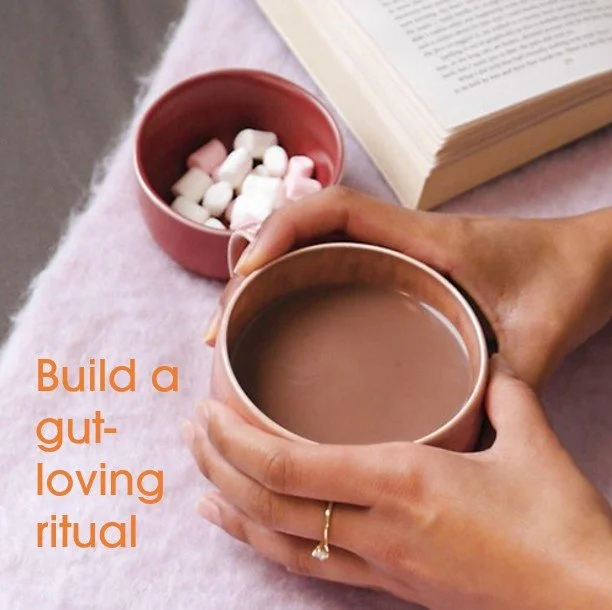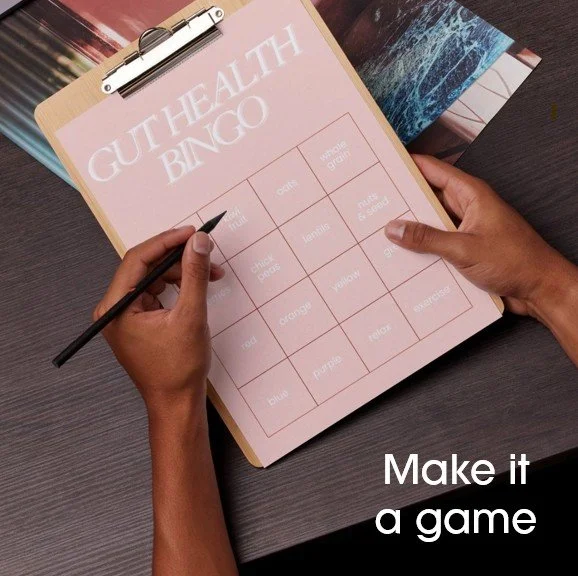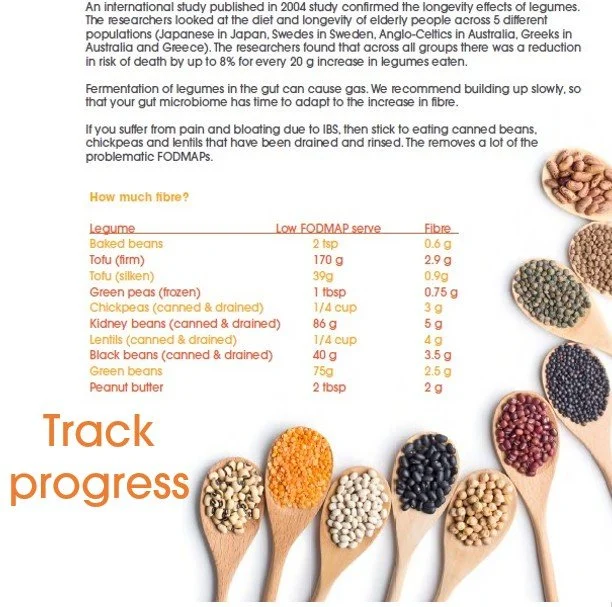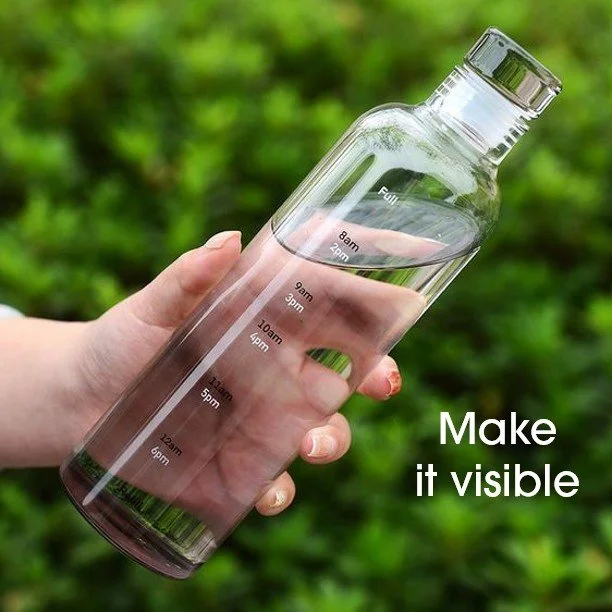Building Habits for Good Gut Health
Gut health isn’t just about what you eat on one day - if only!
It’s about what you do consistently. From sipping a Superflora Gut Health Boost before breakfast to ticking off your weekly plant food rainbow, small rituals can have a big impact on your microbiome. But let’s be honest: knowing what’s good for your gut is one thing. Doing it regularly? That’s where the magic (and the psychology) comes in.
Here’s how to build gut-friendly habits that feel natural, joyful, and sustainable, and are of course backed by science.
Eat the Rainbow (and Count Your Plants)
Your gut microbiome thrives on diversity. That means:
30 different plant foods per week (yes, herbs and spices count!)
28g of fibre per day from whole grains, legumes, nuts, seeds, fruits, and veg (build up to this gradually - find low FODMAP options here )
A rainbow of colours - each hue brings different polyphenols and antioxidants
To make this easier:
Keep a “plant food bingo” sheet or tally chart on your fridge.
Try themed dinners (e.g., “green night” with chicken, pesto and green beans).
Try to add a one new fruit or veggie to your standard shopping cart each week - check out our regular blogs on “what’s in season” for low FODMAP ideas.
Move Your Body, Move Your Bowels
Exercise isn’t just good for your heart, it’s great for your gut. Physical activity helps regulate digestion, reduce bloating, and support a healthy microbiome.
Make it social:
Meet up with friends (human or canine) for a run or walk - movement and connection = double win.
Join a local bushwalking or conservation group and explore native flora while you move.
This taps into social reinforcement, a powerful motivator. When your habits are shared, they’re more likely to stick.
Relaxation is a Gut Health Strategy
Stress can wreak havoc on your gut. Cortisol disrupts digestion, alters gut motility, and even affects your microbiome. Relaxation isn’t a luxury, it’s a gut health essential.
Try to build calming rituals:
Sip your Gut-friendly Hot Chocolate while journaling or reading.
Practice deep breathing or meditation when you wake or before you go to bed.
Spend time in nature - green and blue spaces have been shown to support gut health via the gut-brain axis.
Listen to calming music.
Book in a yoga class or two each week.
Ditch the phone for the last couple of hours before sleep.
Start (or end) Your Day with a Gut-Loving Ritual
One of the easiest ways to build a new habit is to stack it onto something you already do. This is called habit stacking, a concept popularised by James Clear in Atomic Habits. The idea is that you anchor your new behaviour to an existing routine.
For example:
While waiting for the kettle to boil in the morning, drink a glass of Superflora Gut Health Boost. It’s a gentle, nourishing way to wake up your digestive system and set the tone for the day.
After dinner prepare a Superflora Gut-Friendly Hot Chocolate to enjoy as you settle down to watch your favourite show. It’s comforting, delicious, and packed with ingredients your good gut bacteria will love.
These rituals don’t just support your microbiome - they create moments of calm and care that reinforce the habit emotionally.
Use Psychology to Your Advantage
Building habits isn’t about willpower. It’s about designing your environment and mindset to make the healthy choice the easy choice. The habit stacking tip above is a winner, and here are a few more psychological strategies that work wonders for gut health:
1. Planning Ahead
The gut loves consistency, and so do our brains. Planning meals in advance reduces decision fatigue and helps you stay on track. Try:
Meal prepping low FODMAP recipes from our Noisy Guts recipe page. Josephine is particularly good at this. For example, she prepares a big batch of the gut-friendly muesli each Sunday and has breakfasts sorted for the week. I’m trying to build a habit of mixing chia seeds through lactose-free yoghurt each night ready for the next day.
Shopping with a gut-friendly meal plan so your fridge is stocked with low FODMAP and fibre-rich, plant-diverse ingredients. Here is the shopping list for the first 5 days of our Good Gut Challenge plan.
Have a few easy low FODMAP recipes up your sleeve - Check out our mix ‘n match blog - get comfortable with the 6 core recipes and then build endless combos.
Have some grab ‘n go options at hand. Superflora shakes are a great base for smoothies, or a have a low FODMAP sauce or spice mix in your cupboard ready to add instant flavour to dinner.
This taps into implementation intentions—a psychological strategy where you pre-decide when and how you’ll act. It’s like writing a script for your future self.
2. Gamification
Turn gut health into a game. Research shows that gamifying health goals increases motivation and enjoyment.
Try:
Marking off your weekly “plant points”. Aim for 30 different plant foods across the week. Try the ‘plant bingo’ idea mentioned above.
Colour-code your days or even meals to hit the rainbow: aim for red, orange, yellow, green, and blue/purple. Bonus points for fermented foods!
You can even create a friendly competition within your household. Who can hit the rainbow first?
3. Accountability
Tracking progress makes habits stick:
Track your fibre intake (build up slowly to 28g/day). If diarrhoea is an issue, focus on soluble fibre, if constipation is a problem you’ll need both soluble and insoluble fibre. Use our Best Ever Poop Plan ebook to guide you on sources of both, and use the tables with the fibre content of different foods. Just tracking for a few days each month will give you an idea or where you can get some easy wins. Long term food tracking probably does more harm than good.
Note changes in digestion - this will highlight the the benefits of the changes you make.
Accountability doesn’t have to be public. Even a private journal can reinforce your commitment and help you spot patterns. But I have found weekly exercise slots with friends is particularly helpful at keeping me on consistent when it comes to moving my body. No one wants to let down a friend and this taps into the social reinforcement mentioned above.
Make It Easy, Make It Visible
Want your habits to stick? Make them obvious and frictionless:
Keep your Daily Gut Health Boost on the bench, not hidden in the cupboard.
Prep your fibre-rich snacks (e.g., washed blueberries. peeled kiwi fruit, 30g servings of walnuts) and store them at eye level.
Use clear containers for colourful produce - let your fridge inspire you!
If you struggle with constipation, you’ll need to up your water intake as you increase fibre. An observational study showed that people who carried a reusable bottle were 53 percent more consistent with hydration. A great water bottle isn’t just a container - it’s a cue for better behaviour.
Lay out your workout clothes the night before. I’ve been known to wear my workout gear in the office all day to make it easy to go to the gym on the way home.
You can flip this strategy too. If you find yourself doom-scrolling at night, try putting your phone in another room at bedtime.
This aligns with cue-based behaviour: when the cue is visible, the action is more likely to follow.
Celebrate Your Wins
Every week (hey, why not every day!), notice one win - whether it was upping your water intake, hitting your 30 plant foods whatever, write it down and celebrate it.
Every time you spot a win, you see that you can follow through, that progress isn’t just possible, it’s happening. And that tiny spark is what keeps you going, for the next win.
Final Thoughts: Gut Health Is a Journey, Not a Sprint
Building gut-friendly habits isn’t about perfection - it’s about progress. Start small, celebrate wins, and lean into the joy of nourishing your body.
Don’t try to do all of the above in one go. Pick just one and wait until it’s routine before adding something new.
Whether you’re sipping a Daily Gut Health Boost before breakfast, ticking off your plant food bingo, or walking with friends through the bush, every little habit adds up. Your gut will thank you.









